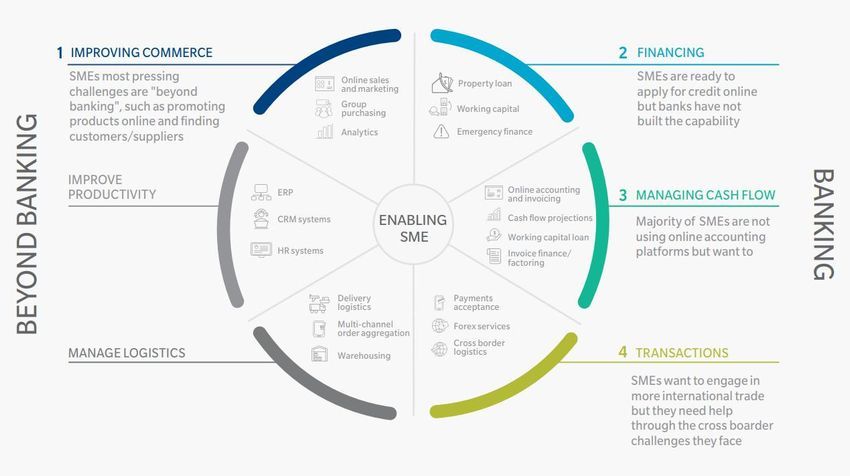If you know at least a bit about banking and financing, you’ve probably heard the term SME and SME gap.
In this article, we are going to tell you more about finances, gaps and what went wrong between investors and SMEs.
Continue reading if you want to find out more why current finance options are failing to serve the missing middle (financial gap).
Page Contents
What is SME?

source:blog.strands.com
By definition, small and medium-sized enterprises (SMEs) are independent firms that employ less than a given number of employees.
This number in the European Union is about 250 employees and the United States considers SMEs to include firms with fewer than 500 employees.
Small firms are considered companies with less than 50 employees and micro-enterprises have 5-10 workers in most cases.
Financial assets are also used to define SMEs. The newest definitions say that medium-sized enterprises (50-249 employees) should not exceed 50 million euros, small enterprises (10-49 employees) should not exceed 10 million euros and micro-enterprise (less than 10 employees) firms should not exceed 2 million euros.
What is SME finance?

source:blog.strands.com
By definition, SME finance is the funding of small or medium-sized companies. This represents a major function in the finance market. The capital is supplied through the financial market in the form or bond issues, bank loans and leasing or hire-purchase arrangements.
The small and medium enterprise (SME) sector is important in the economy and banking. However, these enterprises are still struggling between microloans and larger commercial lending.
In order for SMEs to succeed, they need to move away from targeting high growth companies only, to be more ambitious and to less risk-averse.
SME banking products

source:officialus.net
Some of the SME banking products include:
- Capital loans
- Term Loans
- Supply Chain Finance
- Cash Management Services
- Easy Business Loans
- Current Accounts
- Trade Services
- Treasury Research
SME gap

source:twitter.com
The gap in the available finance that SMEs fall into when looking for capital is referred to as the missing middle.
The largest constraint to the lack of capital prevents the SMEs potential to be released and with that the ability to provide services, goods, pay taxes and create jobs is limited.
Here we are going to look at the reasons why the SME finance gap is occurring.
Unworkable finance types
The first reason why SME gap is occurring is that funders use traditional instruments for financing every SMEs. Enterprises that are located in developing counties are not the same as those in already developed places.
If an instrument worked in the developed world, funders use the same without looking at the needs of the SMEs in developing countries.
These enterprises mostly need simple growth and working capital in the form of debt with good rates that they could easily access.
For some enterprises, equality works, but that is a minority in the market, so funders need to be focused on the specific need of the SME.

source:officialus.net
Disconnect between supply and demand
Most investors are looking for SMEs that have annual growth between 10% and 30%. This is done to manage the risk of investing in frontier markets as well as getting good results back.
The majority of SMEs in developing countries is categorized as low growth and small businesses generate modest growth, but they make a living for their employees.
Experts like Eyal Nachum say that the SME gap occurs because there is a mismatch between expected returns and the reality of the market.
Risk Aversion
The investors are only willing to use tested financial models and they only want to fund enterprises with the highest growth potential. They are doing this to mitigate the risk in the already tumultuous market.
The SME gap persists because those options don’t really serve the minority – the slow-growing, higher risk, moderate return businesses.
These are less attractive investments, but they must be targeted to realize the economic benefits of SME growth.
Combining the finance between public and private sources spreads risk, but investors need to be more ambitious with reach and less ambitious with a return if they want to lower the SME gap.
How to fill in the gap?
In most countries in the world, SMEs are small and unglamorous businesses with low growth. Despite the odds they are still making a profit, paying taxes and hiring staff.

source:theworldbeast.com
Investment options need to be redesigned to suit the needs of SMEs in the markets instead of just rolling out existing funding models.
Some of these criteria could lead to success.
- Debt Finance – with low growth there is little opportunity for successes. Investing in debt finance for growth and easily accessible working capital is needed in order for SMEs to succeed.
- Targeting the right businesses – the real gap is that SMEs have small requirements and modest growth. Enterprises that don’t fit the “box” are already served by existing channels. Because of this, investors need to support and fund the right businesses and SMEs.
- Low Interest Rates – to avoid crippling returns, the interest rates need to be kept only a few percentage points above inflation. This is especially important for developing countries that need all the support they can get.
- Low Security Requirements – there are a lot of SMEs that cannot access their existing finance due to a lack of securities. Unsecured lending needs to be offered. Even though this brings higher risk, as we mentioned above, risk is needed in order for the enterprises to succeed.
- Low Operating Costs – because of all the things we already mentioned, the returns are likely to be modest. The digital platforms for management would have to pay an important role in keeping the costs down. The blended approach could also be used to cover operating costs.
To make progress at scale and to lower the SME banking gap, investors need to be less risk-averse, more ambitious and reach more SMEs that need financing.
There are a lot of really good businesses that turn over a profit and they are being ignored because of the high-growth companies that are glamorous and make good headlines.
The focus needs to be on the impact that is made and reach over growth potential. Without these things, the gap will persist and the SMEs potential, especially in developing countries will never be fully realized.





